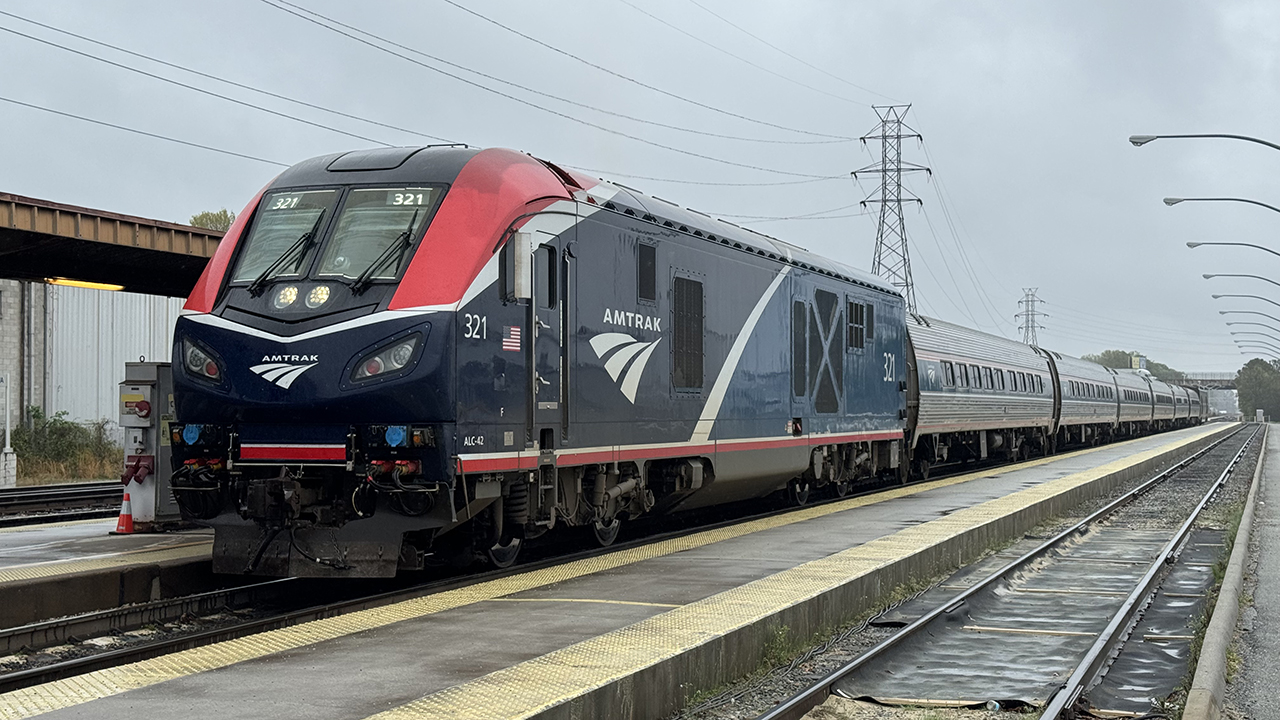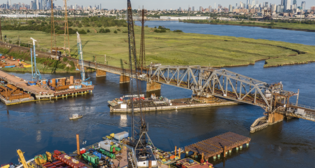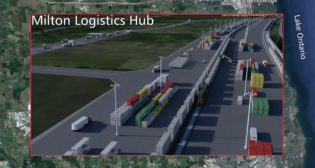
Rail Supply: ‘Buy North American’
Written by Robert H. Cantwell, Contributing Editor
Made in North America: Amtrak Siemens Mobility-built ALC42 321, pulling Train 90, the northbound Palmetto, at Richmond, Va. William C. Vantuono photo.
Almost 10 years ago, CRRC (China Railway Rolling Stock Company), the world’s largest rail rolling stock and railcar components company, a Chinese Communist Party SOE (State-Owned Enterprise), set forth a grand strategy to dominate the North American rail rolling stock industry. CRRC had already caused every Australian rail rolling stock company to go out of business by 2015, and the company was expanding wherever China’s “Belt and Road” initiative took them—plus North America. CRRC’s tactics were simple: Price to penetrate and drive everyone out of business.
CRRC’s Growth in North America
CRRC’s efforts to dominate the North American passenger railcar market started with Massachusetts Bay Transportation Authority (MBTA) in 2014, where CRRC won a bid for 284 cars valued at $566 million. Its bid was $155 million below Hyundai-Rotem, the next lowest bidder; $339 million below third-place Kawasaki Railcar, and a whopping $442 million below fourth-place Bombardier (now Alstom). In 2016, MBTA ordered an additional 120 cars.
In 2017, CRRC won a Southeast Pennsylvania Transportation Authority (SEPTA) order for 45 bilevel Regional Rail cars at a value of $185 million—$34 million below second-place Bombardier.
CRC won a Chicago Transit Authority (CTA) order for 846 cars valued at $1.31 billion in 2016 by underbidding the next closest competitor, also Bombardier, by $226 million.
CRRC continued its offensive in 2017 by winning a Los Angeles Metro order for 64 cars valued at $178 million, with an option for 218 more.
CRRC built plants in Springfield, Mass. at a cost of $95 million and in Chicago at a cost of $100 million, and acquired a facility in Los Angeles to form a production beachhead. Its strategy has been to fabricate carshells in China using low-cost labor and steel, and doing final assembly in the U.S. This is in stark contrast to the many other builders who are far more vertically integrated and fabricate their carshells here, like Alstom and Siemens. Thus, CRRC employs far fewer Americans than its North American competition.
While CRRC and other Chinese investors were plunging headlong into the passenger railcar market, the company invested in a new freight railcar builder in 2014, Vertex Railcar, located in Wilmington, N.C. CRRC had high hopes of participating in the then-hot tank car market—and expanding into other designs rapidly. Vertex had visions of employing 1,300 people in short order. The threat to established carbuilders like Greenbrier, TrinityRail, National Steel Car, FreightCar America and Union Tank Car was real.
So, the North American rail supply base producing passenger and freight railcars and their many components was under attack. CRRC’s ambitions were painfully obvious: to dominate the North American rail supply market by seducing a lot of North American customers with incredibly low, too-good-to-be-true prices.

Congress Wakes Up to the Threat
U.S. passenger transit authorities, North American freight railroads and car owners welcomed the lower prices for rolling stock and components, not considering any long-term strategic impact their decisions may have. In response, the North American rail supply community, under the onslaught of CRRC’s aggression, turned to legislators for help to preserve not only jobs, but entire businesses and potentially an entire industry.
Erik Olson, Executive Director of the Rail Security Alliance, summarized well the several initiatives undertaken by the rail supply community to combat CRRC in a recent editorial in Railway Age:
“The Transportation Infrastructure Vehicle Security Act (TIVSA), signed into law as part of the FY2020 National Defense Authorization Act (NDAA), prevents U.S. transit agencies from accessing federal taxpayer funds when procuring passenger railcars and transit buses from Chinese SOEs. And a section of the 2021 Infrastructure Investment and Jobs Act (IIJA), known as the SAFE TRAINS Act, ensures that no foreign state-owned companies can provide freight rail rolling stock for the U.S. interchange system. Then there are Section 301 tariffs, implemented during the Trump Administration and rightly maintained under President Biden, which further protect American manufacturers and suppliers from China’s anti-competitive, non-market aims.”
The University of Chicago taught me that free-market capitalism drives the lifeblood of the global economy. Open competition is intended to elevate all lives. But when the market is distorted, especially by potentially threatening societies, free-market capitalism requires a re-think. Such is the case with the entire global rail supply industry today.
Russia Invades Ukraine
Russia’s invasion of Ukraine on Feb. 21, 2022 immediately impacted the supply of railcar components (wheels and castings) from Russia into the North American market. Several North American railroads and carbuilders were enjoying the lower prices that Russian supply offered, but when the invasion happened, they scrambled to find more-secure, dependable sources of supply—primarily in North America. The impact of this sudden demand strained incumbent North American suppliers who themselves were recovering from the COVID-19 pandemic, but they ultimately responded to the sudden challenge.
2024: Bad News for CRRC
In 2018, Vertex Railcar went bankrupt due to a swift decline in demand for tank cars. Unable to respond to changing railcar demand, it was forced to cease operations.
In 2022, LA Metro decided not to pursue the options for 218 cars in the CRRC HR4000 contract. Instead, it initiated a new procurement for 182 cars, HR5000. This was awarded to Hyundai-Rotem in February 2024 at a contract price of $664 million.
A March 29, 2024 Commonwealth Beacon headline read: “MBTA Hits Reset on Deal with Railcar Builder. MBTA agreed to pay CRRC $148 million to get delivery of their long overdue, quality plagued railcars.” Imagine having to pay extra to someone who has provided poor quality and woefully late delivery? This incentive, combined with the late deliveries and quality issues, negates any savings MBTA thought it would realize way back in 2014, when MBTA board member Janice Loux said, “This is a win for our riders, this is a win for our financial bottom line, and it’s a win for this authority.”
You be the judge on how much MBTA has won.
Also in March 2024, the European Union initiated its first in-depth investigation of CRRC based on foreign-subsidized unfair competition for its $660 million bid for Bulgarian rolling stock. On March 27, 2024, CRRC withdrew its bid.
Thus, the world is waking up to CRRC’s tactics and the potential impact they have on domestic supply.
On April 15, 2024, SEPTA announced the cancelation “for cause” of its $185 million CRRC contract, citing the railcars were plagued by problems, and the project was years behind schedule, without a single delivery.
While some of CRRC’s problems have been driven by outside forces such as tariffs on imported products and trade restrictions, most were self-inflicted. True, the company experienced similar post-COVID employment issues that all rail suppliers experienced, but numerous quality problems and delivery delays have caused CRRC’s customers to re-think their relationship and seek alternatives.
AAR’s Role in Global Sourcing and Geopolitical Risk
The AAR (Association of American Railroads), whose primary members are the Class I railroads, has spent and continues to spend enormous resources developing an ever-expanding list of global suppliers to drive prices down and “ensure supply chain stability.” As Russia and China have taught us, just the opposite has happened. The AAR repeatedly cites an inability “to pick and choose” suppliers due to their “fiduciary responsibility” to develop new suppliers and stimulate competition. A direct impact of this policy has been the demise of many North American railcar and railcar component supply companies. Our market has been wide open for far too long while other freight and passenger rail markets are closed to imports. It has taken legislative action to level the playing field.

Perhaps the most visible example of unfettered AAR supplier approval is the certification of Inner Mongolia First Machinery Group Ltd. and three other Chinese manufacturers for mechanical couplers. Inner Mongolia is China’s largest military tank producer. It uses its steel foundry to make couplers and tank parts. In the event of a military conflict, this source, and those of the other Chinese counterparts, would no longer be available. It took a trade complaint with resulting tariffs to level the playing field for couplers. The North American market certainly didn’t discourage supply of Chinese couplers as it enjoyed the seductively low prices. Imagine if North American coupler producers went out of business and the industry relied entirely on Chinese supply? Without government intervention, this could have become reality.
Through sharing of AAR specifications and standards, we teach the world about our North American practices. From a financial perspective, AAR captures more revenue through additional testing services, annual recertifications and subscriptions as it captures more suppliers. Nowhere is there in AAR doctrine the need for a strong North American supply chain. This needs to change.
Russia and China, the latter infamous for “acquiring” intellectual property, have taught us valuable lessons in geopolitical risk—something we were blind to until recently. The North American freight rail system remains the envy of the world, and North American rail suppliers were instrumental in getting us there. It’s time to finally recognize that geopolitical risks are real and more needs to be done to “Buy North American.” The future of railway supply depends on working together and not constantly trying to find potentially unfriendly cheap alternatives that drive North American companies out of business. Investing in a North American manufacturing base offers the safest, most stable source for supplying our industry in the many years to come.

Principal of Rail Supply Chain Associates, Robert H. Cantwell spent more than 40 years in executive positions in the rail supply industry. He spent the first 26 years of his rail industry career growing a successful company, Hadady Corp., a designer and manufacturer of truck (bogie) components and systems for locomotives and transit railcars. Following the sale of his business, Bob helped transform Amsted Rail, holding various executive positions for 16 years. He has been active in the Rail Transportation Division of the ASME (American Society of Mechanical Engineers) and is past Chairman of the Division. Bob holds degrees in Mechanical Engineering from the Georgia Institute of Technology and an MBA from the University of Chicago. He possesses a unique perspective on the rail supply industry, combining his engineering experience along with robust economic and financial acumen. As an active investor in the rail industry, he has a vested interest in the success of the industry. He has also actively advocated with members of Congress in support of the rail and rail supply industry. The opinions expressed here are his own.



